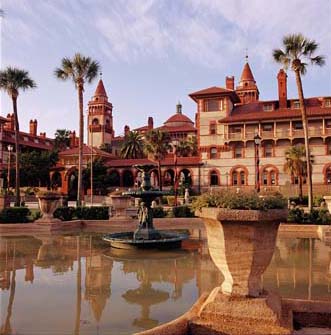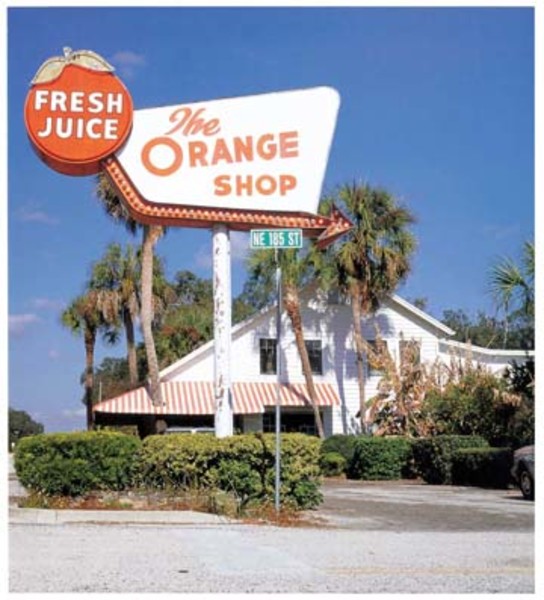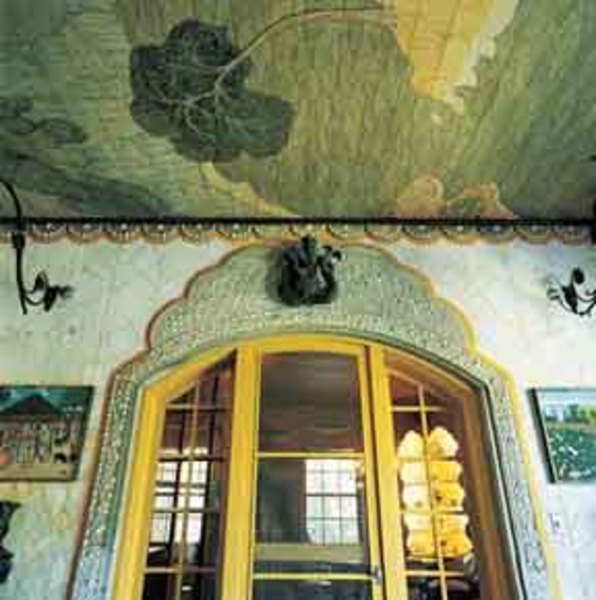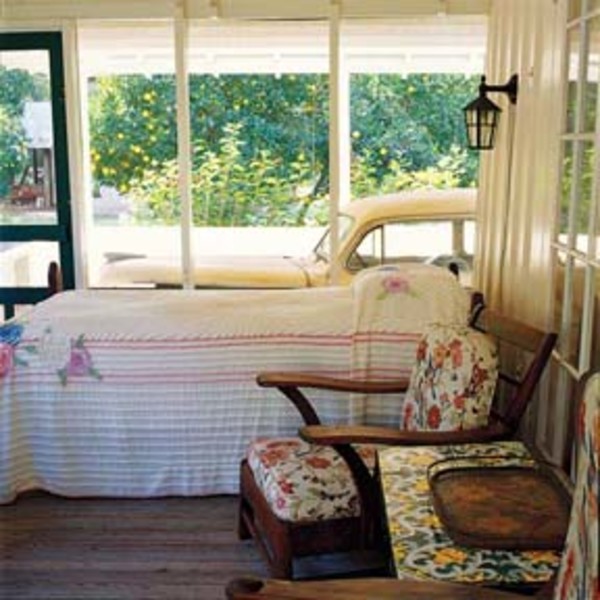
Henry Flagler put St. Augustine on the tourist map with the Hotel Ponce de Leon (now part of Flagler College), designed by Thomas Hastings in 1887.
Once upon a time, long before glittering Miami Vice skyscrapers and Disney fantasies scrawled their signature across the state, there was a whole other Florida. A wild Florida, where legendary “Barefoot Mailmen” trudged sleepy lawless shores before there was a road between Palm Beach and Miami. Where eccentric personalities and powerful magnates flavored the growth of entire towns. And actually, that Florida still exists. Go look for it.
Start with the Barnacle House in Coconut Grove, a house that the Barefoot Mailmen would have known. As a follower of Emerson, pioneer Ralph Munroe tucked his 1891 home into the tranquility of a now rare old-growth hammock on Biscayne Bay; as a naval architect he built a Smart House, with a hurricane- sturdy octagonal core, shipwreck- salvage framing, and a natural air-conditioning system.

Vintage roadside citrus shops, like this one in Citra, are quickly disappearing.
Quintessential Florida means the River of Grass. Paddle silently, observantly through the Everglades’ 10,000 Islands with the brightly dressed ghosts of Seminole Indians in your peripheral vision. Stop off at the Smallwood Store—once a fur-trading frontier outpost and site of a notorious murder, now a museum— and, like John Wayne and Roosevelt, eat stone crab claws at the evocative Rod and Gun Club.
But Florida also means unutterably gorgeous Gilded Age estates: Ringling’s Cà d’Zan in Sarasota, Flagler’s Whitehall in Palm Beach; and Vizcaya, industrialist James Deering’s spectacular winter palazzo in Miami. A thousand artisans put together the cool, antique-strewn interiors, shell grottoes, Italianate gardens, and fanciful breakwaters that so entranced painter John Singer Sargent.
Or there is artists’ Florida. The wild creatures are gone now from Frederic and Evelyn Bartlett’s joyful and painterly romance of a plantation, the Bonnet House on Fort Lauderdale’s beachfront, but it remains a deeply personal vision.

A ceiling at the Bonnet House, the 1921 Fort Lauderdale home of artists Frederic and Evelyn Bartlett
Creep down sandy lanes to find little Cracker cottages, homes to pioneers and cowboys. Rural 1930s has stopped dead in its tracks at writer Marjorie Kinnan Rawling’s home in Cross Creek, an accessible and perfect example. Apalachicola, meanwhile, remains an authentic working seaport, crammed with century-old buildings from its cotton- trade days and beloved by Slow Food seafood junkies and no-glitz slow vacationers.
Edison’s winter home in Naples is a unique glimpse of an endlessly creative mind. A first light bulb still burns in his cluttered laboratory and his humor in “the doghouse”; you’ll see electroliers he designed, the first modern swimming pool; a solution to cat versus bird.
Find the opposite of Disney in Victorian towns like Winter Park with its winding brick streets, canals, moss-draped live oak canopy, and “mansion” charmers like Andalusian farmhouse-style Casa Feliz. Just north, Mount Dora dodged the Shermanlike march of Highway 441 to preserve a historic lakeside resort town that’s become a favorite haunt for antiquers and cyclists. Look for the Steamboat Gothic Donnelly House.

Marjorie Kinnan Rawlings’ old car is parked right next to her sleeping porch in Cross Creek.
Maybe, though, you’ll find the essence of hidden Florida in Vero Beach. Waldo Sexton, quirky builder of the don’t-miss McKee Botanical Garden’s Hall of Giants, has deposited a magpie collection of salvaged Addison Mizner treasures there—check the Driftwood Inn, the Patio, the Ocean Grill.
You can practically hear bankrupted and now-revered Mizner, whose comprehensive vision shaped Boca Raton, as well as Palm Beach’s enchanting shopping district and famed clubs and houses, laughing. Because somehow they work perfectly. But like all the best things in Florida, you’ll have to look for them.
Browsing Old Florida
Architectural Antiques: 2520 SW 28th Ln., Miami (305) 285-1330, miamiantique.com
You could well fall for an Oscar Bach-style cabinet or a chunk of Louis Sullivan terra-cotta, but always hit this 20,000-square-foot warehouse for lighting—’30s palm tree chandeliers, Art Deco slip shades, amazing Mid-century fixtures.
Charles Hosmer Morse Museum of American Art: 445 North Park Ave., Winter Park (407) 645-5311 morsemuseum.org
The museum has an immense collection of the work of Louis Comfort Tiffany, from signature lamps to the chapel he created for the 1893 World’s Columbian Exposition in Chicago.
Craftsman House: 2955 Central Ave., St. Petersburg (727) 323-2787, craftsmanhousegallery.com
Neighborhood café, gallery, and pottery studio in a Historic Kenwood bungalow.
Southern Cross Antiques: Renninger’s Twin Markets, U.S. 441, Mt. Dora, 813-966-4516, southerncrossantiques.net
Mission oak furniture specialist with offerings from diverse Arts and Crafts makers, including all three Stickleys, Limbert, and Lifetime, plus English Arts and Crafts, ceramics, lighting.
Tampa Theatre: 711 Franklin St., Tampa (813) 274-8982 tampatheatre.org
Over-the-top ’20s movie palace makes contemporary film and concert-going a sublime experience.
The Yearling Restaurant: 14531 East County Road 325, Hawthorne (352) 466-3999, yearlingrestaurant.net
Cooter, alligator, sour orange pie—Cracker cooking at its finest, plus a healthy dose of Willie Green’s blues. And lots of books in a pine-paneled ’30s atmosphere.







